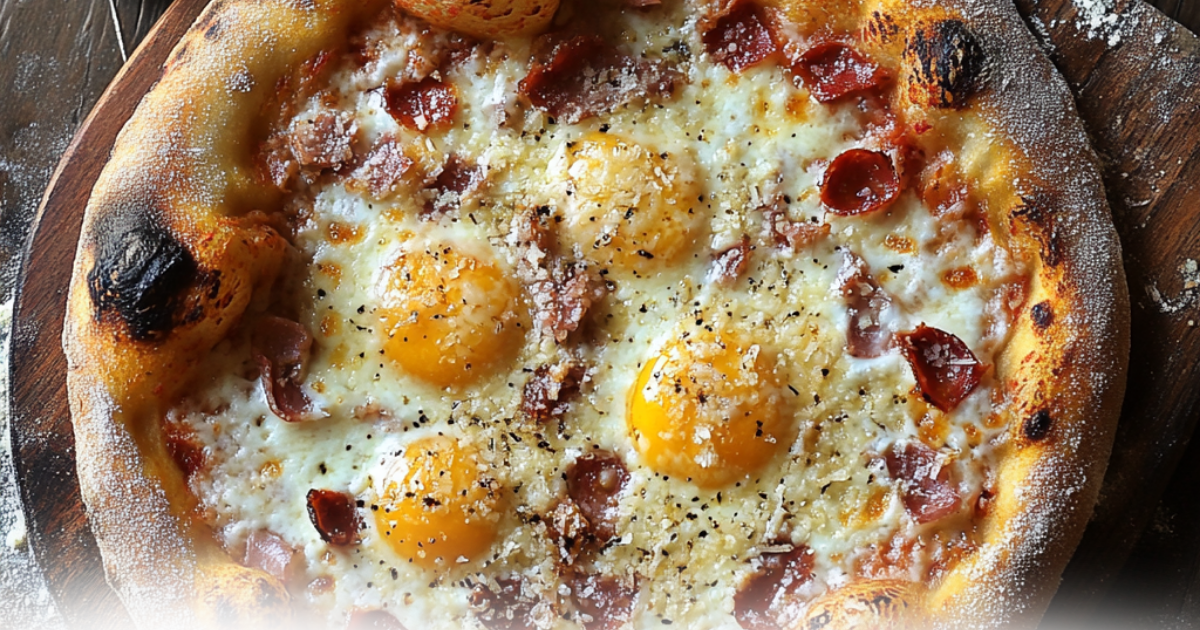Pizza lovers, rejoice! If you’ve ever wondered, “What is carbonara pizza made of?” you’re in for a treat. This article dives deep into the origins, ingredients, and techniques behind this delectable Italian-American creation. Carbonara pizza marries the richness of the classic Roman pasta dish, carbonara, with the universal love for pizza. The result? A creamy, cheesy, and flavorful masterpiece. From the authentic cured meats to the perfect golden egg that ties it all together, we’ll cover everything you need to know. Let’s get started with the fascinating story of its origins.
Table of contents
Origins and Inspiration of Carbonara Pizza
A Fusion of Italian Classics
Carbonara pizza brings together two culinary titans: the beloved Italian pasta dish, carbonara, and the ever-popular pizza. While pasta carbonara dates back to the mid-20th century, pizza carbonara is a modern reinterpretation. It pays homage to Italy’s rich food traditions while embracing global creativity.
Key Components of Traditional Pasta Carbonara
To understand carbonara pizza, it helps to know the basics of pasta carbonara. The dish typically includes guanciale , eggs, Pecorino Romano cheese, and cracked black pepper. Noticeably absent is cream—an ingredient often mistaken as part of the classic recipe. These fundamental flavors are adapted and enhanced when reimagined as pizza toppings.

How Carbonara Inspired Pizza Variations
The leap from pasta to pizza was inevitable. Chefs and food enthusiasts saw an opportunity to combine carbonara’s creamy texture and robust flavor with the crispy-chewy base of pizza. The results are mouthwatering. By swapping pasta for a crust, the dish becomes more versatile, making it perfect for casual dinners or gourmet experiences alike.
Core Ingredients of Carbonara Pizza
Eggs: A Key Ingredient in Carbonara Pizza
The egg is a key player in carbonara pizza, just as it is in pasta carbonara. But instead of being mixed into a sauce, the egg is often cracked directly onto the pizza before baking. As the pizza cooks, the egg becomes the creamy centerpiece, creating a luscious texture that ties the other ingredients together.

Pecorino Romano or Parmesan: Selecting the Right Cheese
Cheese is non-negotiable in carbonara pizza. Traditional recipes lean on Pecorino Romano, a sharp, salty cheese that balances the richness of the egg and chicken. Parmesan cheese is a common substitute and adds a slightly milder, nuttier flavor. Some variations even use a blend of the two for added complexity.

Fior di Latte and Mozzarella: Secondary Cheese Options
Fior di latte, a fresh cow’s milk mozzarella, is often added for its gooey texture and delicate taste. If unavailable, regular mozzarella works just fine. These cheeses provide the melty, stretchy base we all crave in a pizza.
The Role of Black Pepper and Olive Oil
No carbonara dish is complete without freshly cracked black pepper. Its robust, peppery heat cuts through the richness of the toppings, providing a much-needed balance. A drizzle of high-quality olive oil before serving enhances the flavors and adds a touch of authenticity.
Step-by-Step Recipe for Homemade Carbonara Pizza
Preparing the Dough Base
Start with a basic pizza dough. Whether you make it from scratch or use store-bought, the dough should be rolled thin to create a crispy, Neapolitan-style crust. A well-proofed dough ensures the perfect bite.
Cooking the Guanciale or Pancetta
Heat a skillet over medium heat and cook the guanciale or pancetta until it’s golden and crispy. The rendered fat is a flavor bomb—don’t discard it! Use it to brush the pizza base for an extra hit of savory goodness.

Assembling Toppings: Layer by Layer
Begin by spreading a thin layer of olive oil on the dough. Next, sprinkle grated Pecorino Romano or Parmesan cheese generously over the base. Add the crispy guanciale, spreading it evenly to ensure every bite is packed with flavor.
Baking Techniques for Perfect Texture
Preheat your oven to the highest setting (around 500°F or 260°C) and use a pizza stone if possible. Bake the pizza for 7-10 minutes, watching closely. Just before the pizza is done, crack an egg in the center. Bake for another 1-2 minutes until the egg is just set.
Garnishing with Egg and Finishing Touches
Remove the pizza from the oven and immediately top it with a fresh crack of black pepper. If you like, add a sprinkle of parsley or a final drizzle of olive oil. The egg should remain soft, creating a creamy topping that oozes when sliced.

By following these steps, you’ll master the art of creating an unforgettable carbonara pizza. But what if you want to tweak the recipe? In Part 4, we’ll explore some creative variations!
Variations and Customizations
What Is Carbonara Pizza Made Of Without Meat? Vegetarian Options
For those who don’t eat meat, swapping guanciale for a vegetarian-friendly option can be a game-changer. Sautéed mushrooms, smoked tofu, or even artichoke hearts can add a smoky, savory depth to mimic the traditional flavor. While the absence of guanciale alters the dish, these substitutions still offer a satisfying twist on the classic carbonara pizza.
Gluten-Free Crusts for Carbonara Pizza Recipes
If gluten is off the menu, fret not! Carbonara pizza can be enjoyed with a variety of gluten-free crust options. From almond flour bases to cauliflower crusts, there are plenty of alternatives that maintain the crispy texture. Many stores now offer ready-made gluten-free crusts, making it easier than ever to recreate this pizza at home.
Adding Mushrooms, Herbs, or Additional Flavors
For a touch of earthy flavor, toss some sautéed mushrooms onto your pizza. Herbs like fresh parsley or basil can brighten the dish, while a dash of red pepper flakes adds a subtle kick. You can also experiment with truffle oil for a more gourmet version.
Regional and Creative Twists
Chefs worldwide have reimagined carbonaraa pizza by blending regional flavors. For instance, some recipes incorporate crème fraîche or goat cheese for creaminess, while others experiment with smoked salmon or roasted vegetables as toppings. These creative spins make carbonara pizza adaptable for all palates.
For more delicious recipes and creative ideas, check out this detailed carbonara pizza recipe!
Expert Tips for the Perfect Carbonara Pizza
Choosing Fresh and Authentic Ingredients
To truly master what is carbonara pizza made of, start with top-quality ingredients. Opt for authentic guanciale or pancetta, as these cured meats deliver unmatched flavor. Freshly grated Pecorino Romano or Parmesan is a must for its sharp, salty profile, while farm-fresh eggs provide the creamy richness the dish is known for. Avoid pre-shredded cheese, as it often contains additives that prevent smooth melting.
Avoiding Common Mistakes
One common pitfall is overcooking the egg. To achieve the perfect creamy consistency, add the egg toward the end of the baking process and monitor closely. Another frequent error is using too much sauce, which can make the crust soggy. Instead, focus on evenly layering the cheese and toppings. Also, don’t skimp on the black pepper—it’s a defining flavor that balances the richness.
Serving Suggestions for a Complete Meal
Pair your carbonara pizza with a crisp green salad to add a refreshing contrast. A light Italian wine, like Pinot Grigio, complements the rich, salty flavors beautifully. For dessert, try something simple like panna cotta or gelato to keep the Italian theme alive.
With these tips, your carbonara pizza will surely be the highlight of any meal!
Carbonara Pizza in Culinary Culture
Popularity in Italian Restaurants
Carbonara pizza has earned a special place on menus across Italy and beyond. Italian pizzerias often present it as a luxurious option, highlighting its use of traditional ingredients like guanciale and Pecorino Romano. It’s considered a comfort food that celebrates Rome’s culinary legacy.
Carbonara Pizza Across the World
While rooted in Italian tradition, carbonara pizza has gained popularity globally, especially in gourmet pizzerias. Chefs outside Italy often adapt the recipe, using locally available ingredients while staying true to the essence of the dish. This global appeal showcases how versatile and beloved the flavors of carbonara can be.
Comparisons with Other Pizza Styles
Unlike Margherita or pepperoni pizzas, carbonaraa pizza stands out for its creamy egg base and absence of tomato sauce. This unique profile makes it a favorite for those seeking something different yet familiar. Its combination of crispy crust, rich toppings, and bold flavors creates an unforgettable experience.
Carbonaraa pizza is not just a dish—it’s a cultural phenomenon that bridges tradition and innovation. Whether enjoyed in a Roman trattoria or a trendy New York eatery, it continues to captivate food lovers everywhere.
Conclusion and Final Thoughts
Why Carbonara Pizza Deserves a Place on Your Table
Carbonara pizza is a delightful fusion of two beloved Italian dishes, offering a rich, creamy, and savory experience. Whether you’re a fan of traditional carbonara or just curious about what is carbonara pizza made of, this dish invites you to explore bold flavors in a new way. Its unique combination of crispy crust, velvety egg, and salty cheese makes it a crowd-pleaser for any occasion.
Encourage Experimentation and Enjoyment
One of the best things about carbonara pizza is its adaptability. From traditional recipes to modern twists, there’s plenty of room for experimentation. Swap guanciale for vegetarian options, add fresh herbs, or play with regional flavors to create your own signature version. No matter how you customize it, this pizza is sure to bring joy to your table.

